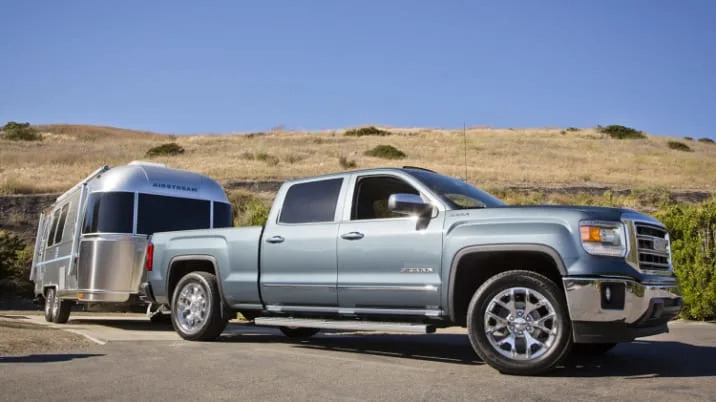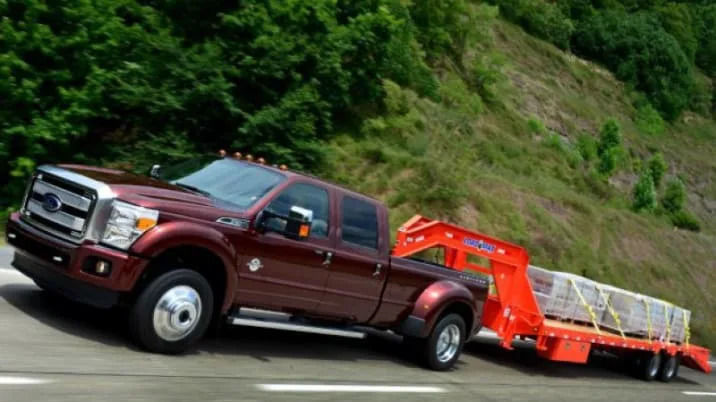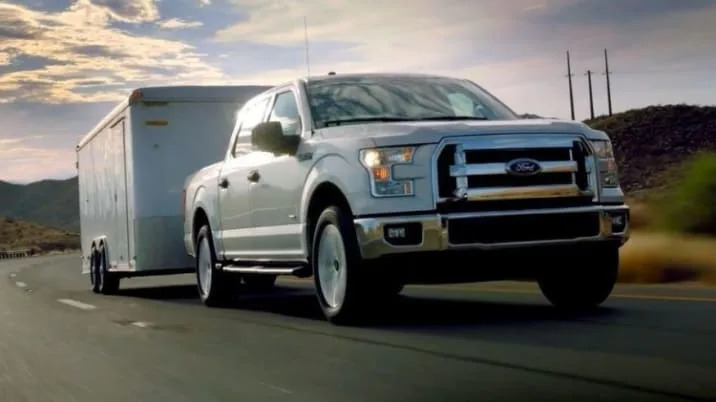Alongside power, economy and payload, trailering ratings are the Holy Grail of light truck marketing. However, despite recently adopted Society of Automotive Engineers (SAE) standards that put everyone on the same footing, the value of tow ratings is almost irrelevant in the real world.
When German sport-utes were a novelty I asked an engineer what the car's fully loaded tow rating was, as opposed to the maximum provided in specifications. He replied with that very same spec number and when pushed (because max tow ratings then always applied to an empty, base-model truck with driver) asked with an incredulous face, "Why would you want to know how much it tows empty, aren't you going to take someone or something with you? Friends? Beer? Barbecue?"
That was prior to development of the SAE J2807 tow-rating standard. J2807 made it possible for buyers to compare various manufacturers's tow ratings on an apples-to-apples basis, unless they compare single-rear wheel pickups with duallies that use different metrics. But some assumptions in J2807 don't reflect typical suburban use.

First, it assumes driver and passenger weigh 150 pounds each, and the truck carries 70 pounds of equipment. Fair enough for a couple perhaps, but with Crew Cabs predominant and many trailerists bringing camping, hunting and wakeboarding gear plus friends and families, not necessarily realistic. Even light commercial guys usually have materiel, tractor attachments or fuel aboard. Using fully loaded trucks would provide a more useful tow rating, right?
J2807 also assumes tongue weight of 10 percent of trailer weight, the light end of the traditionally targeted 10-15 percent. That often becomes an issue with the luxury pickups many families prefer. Truck scales can be sobering places and I've tested pickups with 12,000-pound and 10,000-pound tow ratings that had a real-world payload (Gross Vehicle Weight Rating minus actual scales weight with full fuel and nothing else) of 1,100 and 950 pounds respectively—with the rated trailer at 10 percent tongue you'd be overweight even before anyone or anything was put in the truck. And don't get me started on people who've forgotten geometry and the lever effect, believing that 800 pounds on the tow ball adds 800 pounds on the rear axle.
The standard also assumes the pickup is equipped with the options that one third of that model are equipped with (not including any requisite towing package and hardware), not the majority. That's fine for the fleet buyer ordering thousands of white 2WD rubber-floor regular cabs. But on the street, there are many high-line trims that weigh hundreds of pounds more than lower trims that don't influence the model tow rating. Don't forget any aftermarket parts and some factory upgrades and accessories either, as many wheel choices will drop tow rating by 500 pounds and your rubber-band tires probably won't carry the necessary load.

Ask any half-ton manufacturer what their owners tow and the answer will be less than the maximum or some babble like "92 percent of our owners, if they tow at all, tow 4,000 pounds or less." My inner cynic translates this as 8 percent tow more, or worse, more than they are supposed to...we know it, you know it, we're not saying any more about it.
Those who make the trailers and campers are even more optimistic. RV manufacturers seem to have favorable scales and love high tow ratings since they can then advertise that their products "can be towed by a half-ton pickup." In reality, only one particular regular cab, base trim, 2WD half-ton might be able to tow it—and are you going camping in a fleet-spec truck? A typical options-laded half-ton probably can't do the job.
During my stint in RV publishing test trailers were often delivered anywhere from a few hundred pounds to more than half a ton over brochure unloaded weight. A major camper manufacturer rep brought his latest unit for test on a dually pickup and it was 1,100 pounds over GVWR before anyone got in it. And you'd be surprised how many people forget that fresh water and gasoline are heavier than air.
Based merely on years of observation my German engineer was correct. Very rarely do I see someone pulling an RV or boat that doesn't also have some tools, firewood, coolers, ATV or dirt bike(s), fuel, generator, skis, kayaks or something else along for the ride. Even I usually forget the weight of the canine contingent until wagging tails show up.

Commercial, fleet and many HD-segment buyers use the tow ratings but they also consider things many recreational trailerists overlook. What we really need is a prominent disclaimer, like the EPA numbers on your Monroney sticker: "Your tow rating may vary."
There's only one way to know what your pickup can tow, and it involves a trip to the scales, knowledge of what Gross Combined Weight Rating (GCWR), GVWR and Gross Axle Weight Rating (GAWR) are and how to calculate it all. Sure, the salesman is correct when they say your truck could pull this or that, but will they be in court or the service drive with you if something goes wrong?
Related Video:

When German sport-utes were a novelty I asked an engineer what the car's fully loaded tow rating was, as opposed to the maximum provided in specifications. He replied with that very same spec number and when pushed (because max tow ratings then always applied to an empty, base-model truck with driver) asked with an incredulous face, "Why would you want to know how much it tows empty, aren't you going to take someone or something with you? Friends? Beer? Barbecue?"
That was prior to development of the SAE J2807 tow-rating standard. J2807 made it possible for buyers to compare various manufacturers's tow ratings on an apples-to-apples basis, unless they compare single-rear wheel pickups with duallies that use different metrics. But some assumptions in J2807 don't reflect typical suburban use.

First, it assumes driver and passenger weigh 150 pounds each, and the truck carries 70 pounds of equipment. Fair enough for a couple perhaps, but with Crew Cabs predominant and many trailerists bringing camping, hunting and wakeboarding gear plus friends and families, not necessarily realistic. Even light commercial guys usually have materiel, tractor attachments or fuel aboard. Using fully loaded trucks would provide a more useful tow rating, right?
J2807 also assumes tongue weight of 10 percent of trailer weight, the light end of the traditionally targeted 10-15 percent. That often becomes an issue with the luxury pickups many families prefer. Truck scales can be sobering places and I've tested pickups with 12,000-pound and 10,000-pound tow ratings that had a real-world payload (Gross Vehicle Weight Rating minus actual scales weight with full fuel and nothing else) of 1,100 and 950 pounds respectively—with the rated trailer at 10 percent tongue you'd be overweight even before anyone or anything was put in the truck. And don't get me started on people who've forgotten geometry and the lever effect, believing that 800 pounds on the tow ball adds 800 pounds on the rear axle.
The standard also assumes the pickup is equipped with the options that one third of that model are equipped with (not including any requisite towing package and hardware), not the majority. That's fine for the fleet buyer ordering thousands of white 2WD rubber-floor regular cabs. But on the street, there are many high-line trims that weigh hundreds of pounds more than lower trims that don't influence the model tow rating. Don't forget any aftermarket parts and some factory upgrades and accessories either, as many wheel choices will drop tow rating by 500 pounds and your rubber-band tires probably won't carry the necessary load.

Ask any half-ton manufacturer what their owners tow and the answer will be less than the maximum or some babble like "92 percent of our owners, if they tow at all, tow 4,000 pounds or less." My inner cynic translates this as 8 percent tow more, or worse, more than they are supposed to...we know it, you know it, we're not saying any more about it.
Those who make the trailers and campers are even more optimistic. RV manufacturers seem to have favorable scales and love high tow ratings since they can then advertise that their products "can be towed by a half-ton pickup." In reality, only one particular regular cab, base trim, 2WD half-ton might be able to tow it—and are you going camping in a fleet-spec truck? A typical options-laded half-ton probably can't do the job.
During my stint in RV publishing test trailers were often delivered anywhere from a few hundred pounds to more than half a ton over brochure unloaded weight. A major camper manufacturer rep brought his latest unit for test on a dually pickup and it was 1,100 pounds over GVWR before anyone got in it. And you'd be surprised how many people forget that fresh water and gasoline are heavier than air.
Based merely on years of observation my German engineer was correct. Very rarely do I see someone pulling an RV or boat that doesn't also have some tools, firewood, coolers, ATV or dirt bike(s), fuel, generator, skis, kayaks or something else along for the ride. Even I usually forget the weight of the canine contingent until wagging tails show up.

Commercial, fleet and many HD-segment buyers use the tow ratings but they also consider things many recreational trailerists overlook. What we really need is a prominent disclaimer, like the EPA numbers on your Monroney sticker: "Your tow rating may vary."
There's only one way to know what your pickup can tow, and it involves a trip to the scales, knowledge of what Gross Combined Weight Rating (GCWR), GVWR and Gross Axle Weight Rating (GAWR) are and how to calculate it all. Sure, the salesman is correct when they say your truck could pull this or that, but will they be in court or the service drive with you if something goes wrong?
Related Video:



Sign in to post
Please sign in to leave a comment.
Continue